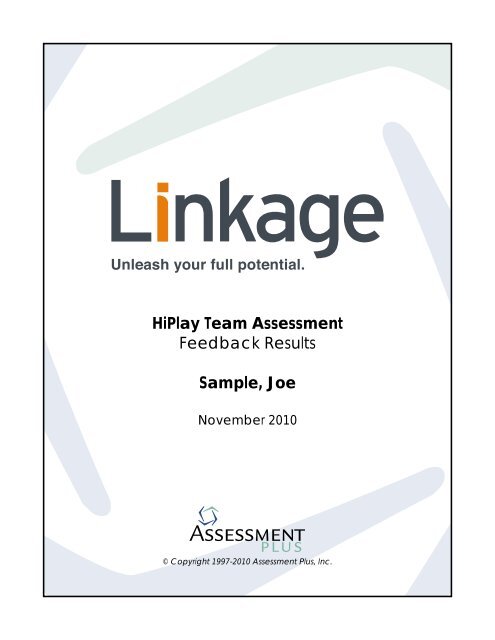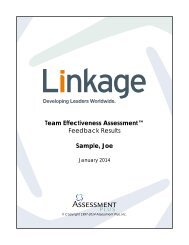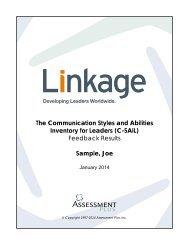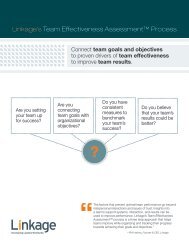HiPlay Team Assessment Feedback Results Sample ... - Linkage, Inc.
HiPlay Team Assessment Feedback Results Sample ... - Linkage, Inc.
HiPlay Team Assessment Feedback Results Sample ... - Linkage, Inc.
You also want an ePaper? Increase the reach of your titles
YUMPU automatically turns print PDFs into web optimized ePapers that Google loves.
<strong>HiPlay</strong> <strong>Team</strong> <strong>Assessment</strong><strong>Feedback</strong> <strong>Results</strong><strong>Sample</strong>, JoeNovember 2010© Copyright 1997-2010 <strong>Assessment</strong> Plus, <strong>Inc</strong>.
IntroductionHiPLAY is an acronym that stands for High Performance Learning-Action-Yield. Theelements of the acronym define an approach to team effectiveness which summarizesmuch of the existing research and literature on high performance teams:(HIGH)(PERFORMANCE)(LEARNING)(ACTION)(YIELD)A far above average, superior, or extraordinarydisplay of sustained, creative, or breakthrough work on a taskwhile continuously improving and gaining in capabilitythrough effective conversations, team interaction and behaviorwhich efficiently produce high quality outputs for team customers.Clearly, this description of the qualities of a high performance team sets a very highstandard of practice for most teams. Few teams have mastered all of the factors whichgo into creating these qualities. Most teams need to improve in some way.This report presents your team profile (the <strong>Team</strong>), prepared with all the data received intime for processing concerning the <strong>Team</strong>. This report contains five parts.• Part I, The HiPLAY Model, explains the model and defines its components.• Part II, the Interpretative Guide, explains what to consider when reviewing theresults.• Part III, <strong>Assessment</strong> <strong>Results</strong>, presents a profile of the <strong>Team</strong> based on thescores you provided to the <strong>Team</strong> and compares them to the combined scores ofall respondents to the HiPLAY assessment.• Part IV, Background Information on the HiPLAY, provides additionalinformation on the instrument.
PART ITHE HIPLAY MODEL
THE HIPLAY TEAM ASSESSMENT TOOLThe HiPLAY assessment tool can be part of a powerful “breakthrough” process forteam learning and growth. It allows a team to generate clear and valid informationabout nearly every aspect of team functioning and provides some important standardsfor the team to consider in setting its own improvement agenda. In effect, the very act ofusing the HiPLAY requires the team to operate like a high performance team – whetherit is or not – by providing an opportunity for significant movement on the road to highperformance. Further movement is a function of how thoroughly the team reviews theresults and uses them to chart a coherent plan of action for both team and individualdevelopment.The HiPLAY assessment is designed to help your team set an improvement agendabased on the standards and practices demonstrated by high performing teams—usingthose key factors which are consistently found to be the critical drivers of teameffectiveness.The following pages contain the overall framework of the HiPLAY in a graphic format,as well as definitions of each of its components and scales.
THE HIPLAY FRAMEWORK<strong>Team</strong> ExecutionAre We Coordinated?Are We Aligned?RULESParticipative LeadershipService DrivenOpen CommunicationEffective ConflictDisciplined ActionCreative ExpressionTARGETSMeaningful MissionClear OutputsAre We Focused?OPERATIONSUseful ToolsPowerful Conversations<strong>Team</strong> LearningAction ActionLearning LearningYield YieldORGANIZATIONEfficient ProcessFlexible StructureValued RewardsAre We Efficient?<strong>Team</strong> DesignAre We Effective?RESULTSSimple Metrics<strong>Team</strong> Productivity<strong>Team</strong> GrowthCOMPETENCIESKnowledgeSkillsCommitmentsAre We Capable?
HiPLAY’S FACTORSThere are twenty scales on the HiPLAY, each scale being the sum of your answers to 4different items on the 80-item instrument. The lowest possible score on any scale is 4and the highest possible score is 20. More importantly, the twenty scales aresubcategories of one of the six major factors of team effectiveness. The factor score isthe simple sum of all of the scale scores from that effectiveness factor, divided by thenumber of scales, so that the score can be plotted on the same 4-20 scale.The six major factors in the HiPLAY framework either relate to <strong>Team</strong> Design (Targets,Organization, and Competencies) or <strong>Team</strong> Execution (Rules, Operations, and <strong>Results</strong>).Each of the six factors enmeshed in this overall HiPLAY Framework are describedbelow.1. The first effectiveness factor (from <strong>Team</strong> Design) is TARGETS. This factoraddresses the question of “Are we focused?” Highly effective teams areconsistently found to be characterized by a clear sense of direction, a deepsense of shared purpose, a mission that demands interdependence, and aclear understanding of the work products which must be produced by theteam in order to accomplish its purpose. Do your scores suggest that yourteam is focused or unfocused?Targets: The extent to which the team has developed focus around workoutputs (products and services) and a challenging purpose that energizesmembers and requires them to work together – a combination ofmeaningful mission and clear outputs.2. The second effectiveness factor (from <strong>Team</strong> Design) is ORGANIZATION.This factor addresses the question of “Are we efficient?” Highly effectiveteams have developed a sensible and efficient approach to getting the workdone. The team has developed a set of work and leadership roles that allowfor an efficient division of labor. Also, the team is operating within a rewardstructure that reinforces and supports effective individual and teamperformance. Do your scores suggest that your team is organized ordisorganized?Organization: The extent to which the team has developed a sensibleand efficient approach to getting the work done – a combination of efficientprocess, flexible structure, and valued rewards.
3. The third effectiveness factor (from <strong>Team</strong> Design) is COMPETENCIES. Thisfactor addresses the question of “Are we capable?” Highly effective teamshave gathered members who have the right knowledge, skills andcommitments to get the work of the team done. When missing keycompetencies, the team seeks out coaching or expertise, or encourages teammembers to develop what’s needed. Do your scores suggest that your teamis capable or incapable?Competencies: The extent to which the team has developed anappropriate distribution of capabilities needed to do the team’s work – acombination of knowledge, skills, and commitments.4. The fourth effectiveness factor (from <strong>Team</strong> Execution) is RULES. This factoraddresses the question of “Are we aligned?” Highly effective teams havedeveloped a set of “rules for engagement” which guide and control theexpression of behavior in the team. Some team rules can be idiosyncratic toparticular teams. However all teams need to align around some that govern(1) how to use power; (2) how to relate to one another; and, (3) how to takeaction around the work of the team. Do your scores suggest that your team isaligned or misaligned?Rules: The extent to which the team has developed a set of rules forengagement that effectively dictate and align how the team uses power,relates to one another, and takes action around its work – a combinationof participative leadership, service driven, open communication, effectiveconflict, disciplined action, and creative expression.5. The fifth effectiveness factor (from <strong>Team</strong> Execution) is OPERATIONS. Thisfactor addresses the question of “Are we coordinated?” Highly effectiveteams have developed consistent methods and practices to ensure that thework of the team, and the interfaces among team members, remain “in sync”,allowing the coherent coordination of action across the team. This is usuallyaccomplished through the use of simple and common team tools, effectiveconversational patterns that drive action, and learning processes which allowcontinuous improvement. Do your scores suggest that your team iscoordinated or uncoordinated?Operations: The extent to which the team has developed consistentmethods and practices to foster coordination in the way it operates – acombination of useful tools, powerful conversations, and team learning.
6. The sixth effectiveness factor (from <strong>Team</strong> Execution) is RESULTS. Thisfactor addresses the question of “Are we effective?” Highly effective teamshave developed a set of simple metrics to continually assess their efficiencyand effectiveness as a team. These metrics are usually designed by theteam, though some measures are derived from the larger organization. Themeasures typically focus on the quality of the work outputs produced by theteam, the level of customer satisfaction, the quality of work processes, or thegrowth in individual or team competence. Do your scores suggest that yourteam is effective or ineffective?<strong>Results</strong>: The extent to which the team has developed a set of metrics tomeasure efficiency and effectiveness – a balance between simple metrics,team productivity, and team growth.All of these factors interact with and influence each other. Changes in one factor willinfluence changes in all of the others. However, each <strong>Team</strong> Design factor is stronglyrelated to one of the <strong>Team</strong> Execution factors. These pairings are noted in the center ofthe HiPLAY diagram. The Targets and <strong>Results</strong> factors are the pair that best defines the“Yield” of the team; the Organization and Operations factors are the pair that bestdefines the “Action” of the team; and the Competencies and Rules factors are the pairthat best defines the “Learning” of the team.The pages that follow demonstrate the scales that comprise each factor, as well as theindividual items (as contained in the HiPLAY) that relate to each scale.
THE SCALES THAT COMPRISE EACH FACTORFACTORTARGETSSCALESMeaningful MissionClear OutputsORGANIZATIONEfficient ProcessFlexible StructureValued RewardsCOMPETENCIESKnowledgeSkillsCommitmentsRULESParticipative LeadershipService DrivenOpen CommunicationEffective ConflictDisciplined ActionCreative ExpressionOPERATIONSUseful ToolsPowerful Conversations<strong>Team</strong> LearningRESULTSSimple Metrics<strong>Team</strong> Productivity<strong>Team</strong> Growth
HiPLAY’S SCALESTARGETSMeaningfulMissionClearOutputsThe extent to which the team has a clear and challenging purposethat energizes members and requires them to work together.The extent to which the team is clear about the specific work outputs(products and services) that must be provided to team customers.ORGANIZATIONEfficientProcessFlexibleStructureValuedRewardsThe extent to which the team has a thoughtful, efficient, andcontinuously improving approach to work processes and operatingprocedures.The extent to which the team has a consistent yet flexible frameworkfor organizing work, roles, relationships, and leadership.The extent to which the team is appropriately recognized andcompensated for both individual and team performance.COMPETENCIESKnowledgeSkillsCommitmentsThe extent to which team members have the data, information,concepts, theories, or experience needed to execute the team’smission and work.The extent to which team members demonstrate in behavior theintellectual, interpersonal, physical, or emotional skills needed to dothe team’s work.The extent to which team members are oriented to effectiveteamwork (i.e., being collaborative, sharing influence, valuingdiversity, and getting results).
RULESParticipativeLeadershipServiceDrivenOpenCommunicationEffectiveConflictDisciplinedActionCreativeExpressionThe extent to which power and leadership is shared among teammembers so that team members are encouraged to takeaccountability for results.The extent to which team members are oriented to supportingothers on the team as well as to meeting the needs of teamcustomers.The extent to which team members speak directly, listen carefully,provide effective feedback, and develop open, honest, and trustfulrelationships.The extent to which team members directly confront and resolveconflicts through sharing valid information and appreciatingopposing views.The extent to which team members use a thoughtful, systematic,logical, and group-centered process to solve problems and makedecisions.The extent to which team members allow each other to innovate,experiment, take risks, explore hunches and intuitions, and havefun.OPERATIONSUsefulToolsPowerfulConversations<strong>Team</strong>LearningThe extent to which the team has effective and user-friendly tools fordesigning and doing the work, as well as for managing people andresults.The extent to which the team demonstrates the conversationalpatterns that enable clear assessment, real inquiry, newpossibilities, and committed action.The extent to which the team can generate an understanding of itsown dynamics and results, and can self-design and self-managechange.
RESULTSSimpleMetrics<strong>Team</strong>Productivity<strong>Team</strong>GrowthThe extent to which the team has relatively simple ways to measurecustomer satisfaction, output quality, process quality, and teamcompetency.The extent to which the team is both efficient and effective inproducing high quality outputs and exceptional results.The extent to which the team is growing in capability for highperformance, and individuals are growing in their competence andcommitment.
PART IIINTERPRETATIVE GUIDE
TEAM DEVELOPMENTMost assessments find that teams are “stuck” around one factor or another, or onescale or another, in their day-to-day functioning. This sense of being “stuck” ismanifested in the same patterns of behavior being demonstrated repeatedly without anyimprovement in results; recurring episodes of conflict around the same issues withoutresolution; or ongoing feelings of frustration, cynicism, resignation or powerlessness.The HiPLAY assessment gives the team an opportunity to gain some distance from itspatterns and to become more conscious of its mode of operating. This can allow forsignificant breakthroughs in team capability and performance. A breakthrough isnothing more than a “breaking up” of the current ineffective pattern and replacing it withsomething that is consciously designed to work better. The six necessary steps tofollow in order to create and sustain breakthroughs in team performance are:1. Recognizing the current pattern as it occurs in the team’s operation.This is what the HiPLAY assessment data provides for the team.2. Understanding and devaluing the negative consequences of the pattern.The team discussion of the HiPLAY data usually brings this out clearly.3. Accepting responsibility personally for one’s own role in the pattern.This is the value of having team members work through a personaldevelopment plan with the HiPLAY data (see Part II of this section).4. Inventing new possibilities for action that break up the pattern.5. Committing to a specific direction or new set of actions.This usually requires several follow-up meetings, or subgroups of the overall team,to fully accomplish.6. Stabilizing the new pattern through conscious repetition and practice.The HiPLAY points to those patterns that are used by high performanceteams. They need to be implemented by the team in everyday meetings andbecome part of the fabric of how the team does its work. This canonly be done through practice, review and follow-up.NOTE: In addition to the six steps noted above, the team can, and should, develop itsown metrics for gauging its progress and effectiveness.To guide you in further understanding your HiPLAY results, the following pagesrepresent a summary of how to interpret both the overall factor scores as well as thescale scores. This information is presented in a series of tables, which includesuggested actions the team might take to improve relatively low scores (scores lowerthan 3).
INTERPRETING THE OVERALL FACTOR SCORESFactor If High (>3.75) If Low (
Factor If High (>3.75) If Low (
How to Read Your Report12374561 Factor Heading – This is the component into which the items are grouped. In this example,“Targets” is shown.2 Symbol Key – This key will be useful in determining the meaning of different symbols usedthroughout the report. The horizontal arrows indicate significant gaps, either positive or negative,between the Self rating and the average rating from any other rater group.3 Scale – In the above example, the rating scale used is a 5-point scale ranging from “AlmostNever Demonstrates” to “Extraordinarily Demonstrates.”4 Item <strong>Results</strong> – This graph shows the results by rater group for a specific item. This and othersimilar items create a category.5 Comparison Lines – These titles depict the different data groups that provided feedback. In thisexample, responses from the <strong>Team</strong> and the participant (labeled as Self) are shown.6 Mean Bar – The bars graphically depict the average of the ratings for each rater group. In thisexample, the average of the ratings from the <strong>Team</strong> is 3.40for the item. The vertical line indicatesthe Self rating. This line is included so that participants can easily see the differences betweentheir Self rating and the ratings of others.7 Distribution – The numbers above each mean bar show the number of ratings provided for eachpoint on the rating scale for that particular comparison line.
PART IIIASSESSMENT RESULTS
Factor SummarySymbol KeyPositive GapNegative Gap1Almost NeverDemonstrates2Rarely Demonstrates3SometimesDemonstrates4ConsistentlyDemonstrates5ExtraordinarilyDemonstratesTARGETSSelfAvg. N1 N2 N3 N4 N53.63 0 0 4 3 1<strong>Team</strong>3.43 0 4 19 13 4ORGANIZATIONSelf<strong>Team</strong>Avg. N1 N2 N3 N4 N53.75 0 3 1 4 43.48 0 11 19 20 10COMPETENCIESSelf<strong>Team</strong>Avg. N1 N2 N3 N4 N53.42 0 5 0 4 33.55 0 13 14 20 13RULESSelfAvg. N1 N2 N3 N4 N53.50 0 4 8 8 4<strong>Team</strong>3.58 0 20 34 42 24OPERATIONSSelf<strong>Team</strong>Avg. N1 N2 N3 N4 N53.33 0 2 5 4 13.35 0 13 22 16 9RESULTSSelfAvg. N1 N2 N3 N4 N54.08 0 2 1 3 6<strong>Team</strong>3.68 0 9 17 18 16Section A<strong>Sample</strong>, JoePage 1Copyright 1997-2010 <strong>Assessment</strong> Plus, <strong>Inc</strong>.
Scale SummarySymbol KeyPositive GapNegative Gap1Almost NeverDemonstrates2Rarely Demonstrates3SometimesDemonstrates4ConsistentlyDemonstrates5ExtraordinarilyDemonstratesTARGETSMeaningful MissionSelfAvg. N1 N2 N3 N4 N53.50 0 0 3 0 1<strong>Team</strong>3.60 0 1 10 5 4Clear OutputsSelfAvg. N1 N2 N3 N4 N53.75 0 0 1 3 0<strong>Team</strong>3.25 0 3 9 8 0ORGANIZATIONEfficient ProcessSelfAvg. N1 N2 N3 N4 N54.50 0 0 1 0 3<strong>Team</strong>3.75 0 3 5 6 6Flexible StructureSelfAvg. N1 N2 N3 N4 N53.75 0 1 0 2 1<strong>Team</strong>3.45 0 2 10 5 3Valued RewardsSelfAvg. N1 N2 N3 N4 N53.00 0 2 0 2 0<strong>Team</strong>3.25 0 6 4 9 1Section B<strong>Sample</strong>, JoePage 2Copyright 1997-2010 <strong>Assessment</strong> Plus, <strong>Inc</strong>.
Scale SummarySymbol KeyPositive GapNegative Gap1Almost NeverDemonstrates2Rarely Demonstrates3SometimesDemonstrates4ConsistentlyDemonstrates5ExtraordinarilyDemonstratesCOMPETENCIESKnowledgeSelfAvg. N1 N2 N3 N4 N53.75 0 1 0 2 1<strong>Team</strong>3.85 0 3 4 6 7SkillsSelfAvg. N1 N2 N3 N4 N53.50 0 2 0 0 2<strong>Team</strong>3.35 0 5 6 6 3CommitmentsSelf<strong>Team</strong>Avg. N1 N2 N3 N4 N53.00 0 2 0 2 03.45 0 5 4 8 3RULESParticipative LeadershipSelf<strong>Team</strong>Avg. N1 N2 N3 N4 N53.75 0 0 2 1 13.70 0 2 6 8 4Service DrivenSelf<strong>Team</strong>Avg. N1 N2 N3 N4 N53.75 0 1 1 0 23.80 0 2 7 4 7Open CommunicationSelf<strong>Team</strong>Avg. N1 N2 N3 N4 N53.25 0 1 1 2 03.55 0 3 5 10 2Section B<strong>Sample</strong>, JoePage 3Copyright 1997-2010 <strong>Assessment</strong> Plus, <strong>Inc</strong>.
Scale SummarySymbol KeyPositive GapNegative Gap1Almost NeverDemonstrates2Rarely Demonstrates3SometimesDemonstrates4ConsistentlyDemonstrates5ExtraordinarilyDemonstratesEffective ConflictSelfAvg. N1 N2 N3 N4 N53.50 0 1 1 1 1<strong>Team</strong>3.35 0 5 7 4 4Disciplined ActionSelfAvg. N1 N2 N3 N4 N53.50 0 0 2 2 0<strong>Team</strong>3.50 0 4 5 8 3Creative ExpressionSelfAvg. N1 N2 N3 N4 N53.25 0 1 1 2 0<strong>Team</strong>3.60 0 4 4 8 4OPERATIONSUseful ToolsSelfAvg. N1 N2 N3 N4 N52.75 0 2 1 1 0<strong>Team</strong>3.20 0 7 3 9 1Powerful ConversationsSelf<strong>Team</strong>Avg. N1 N2 N3 N4 N53.50 0 0 2 2 03.00 0 4 12 4 0<strong>Team</strong> LearningSelf<strong>Team</strong>Avg. N1 N2 N3 N4 N53.75 0 0 2 1 13.85 0 2 7 3 8Section B<strong>Sample</strong>, JoePage 4Copyright 1997-2010 <strong>Assessment</strong> Plus, <strong>Inc</strong>.
Scale SummarySymbol KeyPositive GapNegative Gap1Almost NeverDemonstrates2Rarely Demonstrates3SometimesDemonstrates4ConsistentlyDemonstrates5ExtraordinarilyDemonstratesRESULTSSimple MetricsSelfAvg. N1 N2 N3 N4 N53.50 0 1 1 1 1<strong>Team</strong>3.30 0 4 8 6 2<strong>Team</strong> ProductivitySelfAvg. N1 N2 N3 N4 N54.50 0 0 0 2 2<strong>Team</strong>3.70 0 4 4 6 6<strong>Team</strong> GrowthSelfAvg. N1 N2 N3 N4 N54.25 0 1 0 0 3<strong>Team</strong>4.05 0 1 5 6 8Section B<strong>Sample</strong>, JoePage 5Copyright 1997-2010 <strong>Assessment</strong> Plus, <strong>Inc</strong>.
Factor Individual Responses ComparisonRESULTSTARGETS5EF4ACBD3ABCDEF2FAE1BOPERATIONSCDCDORGANIZATIONBEAFFAEDCBAFEDCBRULESCOMPETENCIES5 Extraordinarily Demonstrates4 Consistently Demonstrates3 Sometimes Demonstrates2 Rarely Demonstrates1 Almost Never DemonstratesSection C<strong>Sample</strong>, JoePage 6Copyright 1997-2010 <strong>Assessment</strong> Plus, <strong>Inc</strong>.
Scale Individual Responses Comparison<strong>Team</strong> GrowthMeaningful Mission<strong>Team</strong> ProductivityClear Outputs5Simple MetricsEfficient ProcessDF C FE AEB 4CEABCD FAF<strong>Team</strong> LearningEABC A CFlexible StructureDEFF3DDBD BEACCEFBAD B2DAPowerfulBC E FValued RewardsConversationsF1A BECCB DDAE FFEADBCD CB AEUseful ToolsFKnowledgeFE AE DD C BC BAFF EDACEDFCA BBBDCreative ExpressionFSkillsBAD E AE FC EDAF CCBC A DFEBDisciplined ActionCommitmentsEffective ConflictParticipativeLeadershipOpen Communication Service Driven5 Extraordinarily Demonstrates4 Consistently Demonstrates3 Sometimes Demonstrates2 Rarely Demonstrates1 Almost Never DemonstratesSection D<strong>Sample</strong>, JoePage 7Copyright 1997-2010 <strong>Assessment</strong> Plus, <strong>Inc</strong>.
TARGETSSymbol KeyPositive GapNegative Gap1Almost NeverDemonstrates2Rarely Demonstrates3SometimesDemonstrates4ConsistentlyDemonstrates5ExtraordinarilyDemonstratesScale: Meaningful MissionSelf<strong>Team</strong>Avg. N1 N2 N3 N4 N53.50 0 0 3 0 13.60 0 1 10 5 41The team has an overall purpose—or specific reason for existing—that is clearly understood andaccepted by all team members.SelfAvg. N1 N2 N3 N4 N53.00 0 0 1 0 0<strong>Team</strong>3.40 0 1 2 1 121<strong>Team</strong> members talk about the team mission as an opportunity to create important results for the largerorganization.SelfAvg. N1 N2 N3 N4 N53.00 0 0 1 0 0<strong>Team</strong>3.80 0 0 3 0 241It is clear that achieving the mission or purpose of the team requires people to depend on each otherand to work together effectively.SelfAvg. N1 N2 N3 N4 N55.00 0 0 0 0 1<strong>Team</strong>4.00 0 0 1 3 161<strong>Team</strong> members talk about the team's mission or purpose as personally important and meaningful totheir own work, profession or career success.SelfAvg. N1 N2 N3 N4 N53.00 0 0 1 0 0<strong>Team</strong>3.20 0 0 4 1 0Section E<strong>Sample</strong>, JoePage 8Copyright 1997-2010 <strong>Assessment</strong> Plus, <strong>Inc</strong>.
TARGETSSymbol KeyPositive GapNegative Gap1Almost NeverDemonstrates2Rarely Demonstrates3SometimesDemonstrates4ConsistentlyDemonstrates5ExtraordinarilyDemonstratesScale: Clear OutputsSelf<strong>Team</strong>Avg. N1 N2 N3 N4 N53.75 0 0 1 3 03.25 0 3 9 8 02The work of the team is spelled out in terms of clear and specific outputs (e.g., products, services,decisions, reports, analyses, etc.).SelfAvg. N1 N2 N3 N4 N54.00 0 0 0 1 0<strong>Team</strong>3.20 0 0 4 1 022<strong>Team</strong> members are clear about the individual work outputs that each person must produce if the teamas a whole is to succeed.SelfAvg. N1 N2 N3 N4 N53.00 0 0 1 0 0<strong>Team</strong>3.00 0 1 3 1 042Individual and teamwork outputs are stated so that the quality and effectiveness of what is produced canbe reasonably assessed.SelfAvg. N1 N2 N3 N4 N54.00 0 0 0 1 0<strong>Team</strong>3.40 0 1 1 3 062<strong>Team</strong> members talk with each other quite often to ensure consensus around the many goals andpriorities of the team regarding work outputs.SelfAvg. N1 N2 N3 N4 N54.00 0 0 0 1 0<strong>Team</strong>3.40 0 1 1 3 0Section E<strong>Sample</strong>, JoePage 9Copyright 1997-2010 <strong>Assessment</strong> Plus, <strong>Inc</strong>.
ORGANIZATIONSymbol KeyPositive GapNegative Gap1Almost NeverDemonstrates2Rarely Demonstrates3SometimesDemonstrates4ConsistentlyDemonstrates5ExtraordinarilyDemonstratesScale: Efficient ProcessSelf<strong>Team</strong>Avg. N1 N2 N3 N4 N54.50 0 0 1 0 33.75 0 3 5 6 63The team has developed a thoughtful and concrete approach to doing the work needed to accomplishthe mission of the team.SelfAvg. N1 N2 N3 N4 N55.00 0 0 0 0 1<strong>Team</strong>3.80 0 1 1 1 223The work processes of the team (e.g., planning, problem-solving, decision-making) are well-designed,organized and efficient.SelfAvg. N1 N2 N3 N4 N53.00 0 0 1 0 0<strong>Team</strong>3.60 0 1 1 2 143The team has a set of operating procedures for routine activities (e.g., running meetings, sharinginformation, etc.) that are well understood, useful and efficient.SelfAvg. N1 N2 N3 N4 N55.00 0 0 0 0 1<strong>Team</strong>3.40 0 1 2 1 163<strong>Team</strong> members actively seek to improve work processes and operating procedures to drive greaterefficiency and effectiveness.SelfAvg. N1 N2 N3 N4 N55.00 0 0 0 0 1<strong>Team</strong>4.20 0 0 1 2 2Section E<strong>Sample</strong>, JoePage 10Copyright 1997-2010 <strong>Assessment</strong> Plus, <strong>Inc</strong>.
ORGANIZATIONSymbol KeyPositive GapNegative Gap1Almost NeverDemonstrates2Rarely Demonstrates3SometimesDemonstrates4ConsistentlyDemonstrates5ExtraordinarilyDemonstratesScale: Flexible StructureSelf<strong>Team</strong>Avg. N1 N2 N3 N4 N53.75 0 1 0 2 13.45 0 2 10 5 34<strong>Team</strong> members assume work roles on the team based upon their demonstrated talent, abilities andcommitment.SelfAvg. N1 N2 N3 N4 N54.00 0 0 0 1 0<strong>Team</strong>3.40 0 0 3 2 024The team has at least one member who usually takes the lead on driving the work and handling the"people problems" of the team.SelfAvg. N1 N2 N3 N4 N55.00 0 0 0 0 1<strong>Team</strong>4.00 0 0 2 1 244The team distributes leadership responsibilities across many team members (not just the formallyappointed team leader).SelfAvg. N1 N2 N3 N4 N54.00 0 0 0 1 0<strong>Team</strong>3.40 0 1 2 1 164The team allows work and leadership roles to change as needed to ensure that the team can meet thechanging requirements of the work.SelfAvg. N1 N2 N3 N4 N52.00 0 1 0 0 0<strong>Team</strong>3.00 0 1 3 1 0Section E<strong>Sample</strong>, JoePage 11Copyright 1997-2010 <strong>Assessment</strong> Plus, <strong>Inc</strong>.
ORGANIZATIONSymbol KeyPositive GapNegative Gap1Almost NeverDemonstrates2Rarely Demonstrates3SometimesDemonstrates4ConsistentlyDemonstrates5ExtraordinarilyDemonstratesScale: Valued RewardsSelf<strong>Team</strong>Avg. N1 N2 N3 N4 N53.00 0 2 0 2 03.25 0 6 4 9 15Individual team members are recognized for their individual contributions to the overall success of theteam.SelfAvg. N1 N2 N3 N4 N52.00 0 1 0 0 0<strong>Team</strong>3.20 0 2 0 3 025The team periodically celebrates its accomplishments as a team via ceremonies, parties or other meansavailable.SelfAvg. N1 N2 N3 N4 N54.00 0 0 0 1 0<strong>Team</strong>3.60 0 1 1 2 145An important part of individual team member compensation is based on the success of the team as awhole in delivering its work outputs.SelfAvg. N1 N2 N3 N4 N52.00 0 1 0 0 0<strong>Team</strong>2.80 0 2 2 1 065<strong>Team</strong> members talk about the work of the team, and participating in it, as personally rewardingregardless of the compensation involved.SelfAvg. N1 N2 N3 N4 N54.00 0 0 0 1 0<strong>Team</strong>3.40 0 1 1 3 0Section E<strong>Sample</strong>, JoePage 12Copyright 1997-2010 <strong>Assessment</strong> Plus, <strong>Inc</strong>.
COMPETENCIESSymbol KeyPositive GapNegative Gap1Almost NeverDemonstrates2Rarely Demonstrates3SometimesDemonstrates4ConsistentlyDemonstrates5ExtraordinarilyDemonstratesScale: KnowledgeSelfAvg. N1 N2 N3 N4 N53.75 0 1 0 2 1<strong>Team</strong>3.85 0 3 4 6 76The team has the knowledge it needs about the larger business context of its work (e.g., customers,competitors, industry trends, other social/cultural/political issues, etc.)SelfAvg. N1 N2 N3 N4 N52.00 0 1 0 0 0<strong>Team</strong>4.00 0 1 1 0 326The team has the knowledge that it needs about the larger organization (e.g., strategies, goals, policies,plans, procedures, culture, etc.).SelfAvg. N1 N2 N3 N4 N54.00 0 0 0 1 0<strong>Team</strong>4.20 0 0 1 2 246The team has the knowledge that it needs around the functional or technical disciplines involved in itswork (e.g., engineering, marketing, manufacturing, finance, HR, IS, etc.).SelfAvg. N1 N2 N3 N4 N54.00 0 0 0 1 0<strong>Team</strong>3.60 0 1 1 2 166The team has the knowledge it needs around the work processes, tools, machinery or other materialsinvolved in its work.SelfAvg. N1 N2 N3 N4 N55.00 0 0 0 0 1<strong>Team</strong>3.60 0 1 1 2 1Section E<strong>Sample</strong>, JoePage 13Copyright 1997-2010 <strong>Assessment</strong> Plus, <strong>Inc</strong>.
COMPETENCIESSymbol KeyPositive GapNegative Gap1Almost NeverDemonstrates2Rarely Demonstrates3SometimesDemonstrates4ConsistentlyDemonstrates5ExtraordinarilyDemonstratesScale: SkillsSelfAvg. N1 N2 N3 N4 N53.50 0 2 0 0 2<strong>Team</strong>3.35 0 5 6 6 37The team has the intellectual skills that it needs among members to create high quality work (e.g.,analytical thinking, logical thinking, creative thinking, systems thinking, etc.).SelfAvg. N1 N2 N3 N4 N55.00 0 0 0 0 1<strong>Team</strong>4.00 0 0 1 3 127The team has the interpersonal skills that it needs among members to create high quality work.Avg. N1 N2 N3 N4 N5Self5.00 0 0 0 0 1<strong>Team</strong>3.60 0 1 1 2 147The team has the physical skills it needs among members (e.g., stamina, energy, stress tolerance,dexterity, tool manipulation, etc.) to create high quality work.SelfAvg. N1 N2 N3 N4 N52.00 0 1 0 0 0<strong>Team</strong>2.80 0 3 1 0 167The team has the emotional management skills it needs among members (e.g., self-control, recognizingothers' feelings, expressing feelings, self-awareness, etc.) to create high quality work.SelfAvg. N1 N2 N3 N4 N52.00 0 1 0 0 0<strong>Team</strong>3.00 0 1 3 1 0Section E<strong>Sample</strong>, JoePage 14Copyright 1997-2010 <strong>Assessment</strong> Plus, <strong>Inc</strong>.
COMPETENCIESSymbol KeyPositive GapNegative Gap1Almost NeverDemonstrates2Rarely Demonstrates3SometimesDemonstrates4ConsistentlyDemonstrates5ExtraordinarilyDemonstratesScale: CommitmentsSelf<strong>Team</strong>Avg. N1 N2 N3 N4 N53.00 0 2 0 2 03.45 0 5 4 8 38<strong>Team</strong> members seem motivated to exercise power in a balanced way, i.e., they are not afraid to statetheir own view, or take the lead, but are also open to challenge and feedback from others.SelfAvg. N1 N2 N3 N4 N52.00 0 1 0 0 0<strong>Team</strong>3.00 0 2 1 2 028<strong>Team</strong> members are motivated to build collaborative relationships with each other, i.e., they seek to buildpartnerships and solutions to problems where everyone can win.SelfAvg. N1 N2 N3 N4 N54.00 0 0 0 1 0<strong>Team</strong>3.80 0 1 0 3 148<strong>Team</strong> members are motivated to produce high quality results, continuously improve their work andoutperform previous standards.SelfAvg. N1 N2 N3 N4 N54.00 0 0 0 1 0<strong>Team</strong>3.80 0 1 1 1 268<strong>Team</strong> members seem motivated by having people of diverse backgrounds and points of view on theteam, i.e., they enjoy "differences" and use them to produce better solutions to problems.SelfAvg. N1 N2 N3 N4 N52.00 0 1 0 0 0<strong>Team</strong>3.20 0 1 2 2 0Section E<strong>Sample</strong>, JoePage 15Copyright 1997-2010 <strong>Assessment</strong> Plus, <strong>Inc</strong>.
RULESSymbol KeyPositive GapNegative Gap1Almost NeverDemonstrates2Rarely Demonstrates3SometimesDemonstrates4ConsistentlyDemonstrates5ExtraordinarilyDemonstratesScale: Participative LeadershipSelf<strong>Team</strong>Avg. N1 N2 N3 N4 N53.75 0 0 2 1 13.70 0 2 6 8 49Organizational status or individual power differences within the team are not allowed to get in the way ofthe free flow of information and ideas, or the quality of decision-making.SelfAvg. N1 N2 N3 N4 N55.00 0 0 0 0 1<strong>Team</strong>3.80 0 1 1 1 229<strong>Team</strong> members are expected to make free and informed choices about their work and participation inthe team, i.e., coercion or autocratic actions are not tolerated.SelfAvg. N1 N2 N3 N4 N53.00 0 0 1 0 0<strong>Team</strong>3.60 0 1 1 2 149<strong>Team</strong> members are encouraged to take charge of their part of the work and to accept accountability forproducing what the team needs from them.SelfAvg. N1 N2 N3 N4 N54.00 0 0 0 1 0<strong>Team</strong>3.40 0 0 3 2 069<strong>Team</strong> leaders provide direction, expertise and coaching as needed, but are also open to the input andparticipation of all members in making key decisions.SelfAvg. N1 N2 N3 N4 N53.00 0 0 1 0 0<strong>Team</strong>4.00 0 0 1 3 1Section E<strong>Sample</strong>, JoePage 16Copyright 1997-2010 <strong>Assessment</strong> Plus, <strong>Inc</strong>.
RULESSymbol KeyPositive GapNegative Gap1Almost NeverDemonstrates2Rarely Demonstrates3SometimesDemonstrates4ConsistentlyDemonstrates5ExtraordinarilyDemonstratesScale: Service DrivenSelf<strong>Team</strong>Avg. N1 N2 N3 N4 N53.75 0 1 1 0 23.80 0 2 7 4 710<strong>Team</strong> members regularly provide help, coaching and support to each other to ensure that everyonesucceeds.SelfAvg. N1 N2 N3 N4 N55.00 0 0 0 0 1<strong>Team</strong>3.60 0 0 3 1 130<strong>Team</strong> members show a genuine respect for the needs, concerns and contributions of every teammember.SelfAvg. N1 N2 N3 N4 N55.00 0 0 0 0 1<strong>Team</strong>4.40 0 0 1 1 350<strong>Team</strong> members feel a shared accountability for the success of the team that goes beyond theindividual's own work, e.g., people help out wherever they are needed.SelfAvg. N1 N2 N3 N4 N52.00 0 1 0 0 0<strong>Team</strong>3.80 0 1 1 1 270<strong>Team</strong> members continuously seek new and more valuable ways to serve the customers of the team.Avg. N1 N2 N3 N4 N5Self3.00 0 0 1 0 0<strong>Team</strong>3.40 0 1 2 1 1Section E<strong>Sample</strong>, JoePage 17Copyright 1997-2010 <strong>Assessment</strong> Plus, <strong>Inc</strong>.
RULESSymbol KeyPositive GapNegative Gap1Almost NeverDemonstrates2Rarely Demonstrates3SometimesDemonstrates4ConsistentlyDemonstrates5ExtraordinarilyDemonstratesScale: Open CommunicationSelfAvg. N1 N2 N3 N4 N53.25 0 1 1 2 0<strong>Team</strong>3.55 0 3 5 10 211Communication among team members is direct, open, genuine and non-defensive.SelfAvg. N1 N2 N3 N4 N54.00 0 0 0 1 0<strong>Team</strong>3.60 0 1 1 2 131<strong>Team</strong> members listen closely to others as they speak, helping each member to state his/her viewpointwithout interruption.SelfAvg. N1 N2 N3 N4 N52.00 0 1 0 0 0<strong>Team</strong>3.40 0 1 1 3 051<strong>Team</strong> members provide regular and effective feedback about each other's behavior, ideas and/ordecisions.SelfAvg. N1 N2 N3 N4 N53.00 0 0 1 0 0<strong>Team</strong>3.80 0 0 2 2 171<strong>Team</strong> members act towards each other with honesty, integrity and a clear sense of trust.Avg. N1 N2 N3 N4 N5Self4.00 0 0 0 1 0<strong>Team</strong>3.40 0 1 1 3 0Section E<strong>Sample</strong>, JoePage 18Copyright 1997-2010 <strong>Assessment</strong> Plus, <strong>Inc</strong>.
RULESSymbol KeyPositive GapNegative Gap1Almost NeverDemonstrates2Rarely Demonstrates3SometimesDemonstrates4ConsistentlyDemonstrates5ExtraordinarilyDemonstratesScale: Effective ConflictSelf<strong>Team</strong>Avg. N1 N2 N3 N4 N53.50 0 1 1 1 13.35 0 5 7 4 412When faced with breakdowns in team performance, team members tend to focus on finding solutions,not on complaining or placing blame on each other.SelfAvg. N1 N2 N3 N4 N53.00 0 0 1 0 0<strong>Team</strong>3.80 0 0 2 2 132When confronting difficult problems or conflicts, team members actively seek valid information about thefacts, beliefs and assumptions underlying the situation.SelfAvg. N1 N2 N3 N4 N52.00 0 1 0 0 0<strong>Team</strong>2.60 0 2 3 0 052In a conflict, team members are encouraged to clearly advocate their own position as well as to fullyunderstand and appreciate the opposing points of view.SelfAvg. N1 N2 N3 N4 N55.00 0 0 0 0 1<strong>Team</strong>3.80 0 1 1 1 272When a conflict occurs within the team, it is openly discussed and confronted so that a "commonground" for action can be found.SelfAvg. N1 N2 N3 N4 N54.00 0 0 0 1 0<strong>Team</strong>3.20 0 2 1 1 1Section E<strong>Sample</strong>, JoePage 19Copyright 1997-2010 <strong>Assessment</strong> Plus, <strong>Inc</strong>.
RULESSymbol KeyPositive GapNegative Gap1Almost NeverDemonstrates2Rarely Demonstrates3SometimesDemonstrates4ConsistentlyDemonstrates5ExtraordinarilyDemonstratesScale: Disciplined ActionSelf<strong>Team</strong>Avg. N1 N2 N3 N4 N53.50 0 0 2 2 03.50 0 4 5 8 313<strong>Team</strong> members are thoughtful, disciplined and thorough when solving problems and making decisions.Avg. N1 N2 N3 N4 N5Self3.00 0 0 1 0 0<strong>Team</strong>3.80 0 1 1 1 233The team is systematic in its approach to solving problems, i.e., team members rigorously analyzeproblem causes and alternative solutions.SelfAvg. N1 N2 N3 N4 N54.00 0 0 0 1 0<strong>Team</strong>3.40 0 2 0 2 153The team follows a logical, step-by-step process for working through difficult, complex or emotionalissues.SelfAvg. N1 N2 N3 N4 N54.00 0 0 0 1 0<strong>Team</strong>3.20 0 1 2 2 073<strong>Team</strong> members are willing to "do whatever it takes" to have the team succeed regardless of theirpersonal preferences, interests or opinions.SelfAvg. N1 N2 N3 N4 N53.00 0 0 1 0 0<strong>Team</strong>3.60 0 0 2 3 0Section E<strong>Sample</strong>, JoePage 20Copyright 1997-2010 <strong>Assessment</strong> Plus, <strong>Inc</strong>.
RULESSymbol KeyPositive GapNegative Gap1Almost NeverDemonstrates2Rarely Demonstrates3SometimesDemonstrates4ConsistentlyDemonstrates5ExtraordinarilyDemonstratesScale: Creative ExpressionSelf<strong>Team</strong>Avg. N1 N2 N3 N4 N53.25 0 1 1 2 03.60 0 4 4 8 414<strong>Team</strong> members actively seek to create new possibilities, innovations and breakthroughs in the team'swork.SelfAvg. N1 N2 N3 N4 N54.00 0 0 0 1 0<strong>Team</strong>3.60 0 1 1 2 134<strong>Team</strong> members are encouraged to experiment, take risks, explore new ideas and try things out withoutfear of punishment or embarrassment.SelfAvg. N1 N2 N3 N4 N52.00 0 1 0 0 0<strong>Team</strong>3.00 0 2 1 2 054The team engages in creative dialogues to question and explore underlying assumptions, theories orintuitive ideas about problems facing the team.SelfAvg. N1 N2 N3 N4 N53.00 0 0 1 0 0<strong>Team</strong>4.00 0 0 1 3 174When it is really needed, the team takes the time to relax, have fun and relieve the pressure and stressof the work.SelfAvg. N1 N2 N3 N4 N54.00 0 0 0 1 0<strong>Team</strong>3.80 0 1 1 1 2Section E<strong>Sample</strong>, JoePage 21Copyright 1997-2010 <strong>Assessment</strong> Plus, <strong>Inc</strong>.
OPERATIONSSymbol KeyPositive GapNegative Gap1Almost NeverDemonstrates2Rarely Demonstrates3SometimesDemonstrates4ConsistentlyDemonstrates5ExtraordinarilyDemonstratesScale: Useful ToolsSelfAvg. N1 N2 N3 N4 N52.75 0 2 1 1 0<strong>Team</strong>3.20 0 7 3 9 115The team has useful tools for defining and designing the work of the team (e.g., information gathering,goal-setting, planning, organizing, etc.).SelfAvg. N1 N2 N3 N4 N53.00 0 0 1 0 0<strong>Team</strong>3.20 0 1 2 2 035The team has useful tools for managing the execution and flow of the work (e.g., problem analysis,running meetings, project management, etc.).SelfAvg. N1 N2 N3 N4 N54.00 0 0 0 1 0<strong>Team</strong>3.80 0 1 0 3 155The team has useful tools for managing "people practices" (e.g., hiring, performance reviews,compensation, individual development, etc.).SelfAvg. N1 N2 N3 N4 N52.00 0 1 0 0 0<strong>Team</strong>3.40 0 1 1 3 075The team has useful tools for tracking the results produced by individuals or the team as a whole (e.g.,project reviews, quality assessments, customer satisfaction, etc.).SelfAvg. N1 N2 N3 N4 N52.00 0 1 0 0 0<strong>Team</strong>2.40 0 4 0 1 0Section E<strong>Sample</strong>, JoePage 22Copyright 1997-2010 <strong>Assessment</strong> Plus, <strong>Inc</strong>.
OPERATIONSSymbol KeyPositive GapNegative Gap1Almost NeverDemonstrates2Rarely Demonstrates3SometimesDemonstrates4ConsistentlyDemonstrates5ExtraordinarilyDemonstratesScale: Powerful ConversationsSelf<strong>Team</strong>Avg. N1 N2 N3 N4 N53.50 0 0 2 2 03.00 0 4 12 4 016When discussing problems, conflicts or work breakdowns, team members express their emotionseffectively and produce clear statements of "what's wrong."SelfAvg. N1 N2 N3 N4 N53.00 0 0 1 0 0<strong>Team</strong>2.80 0 1 4 0 036When discussing an issue, team members talk about the data or evidence which leads to their individualconclusions, beliefs or assertions about the issue.SelfAvg. N1 N2 N3 N4 N54.00 0 0 0 1 0<strong>Team</strong>2.80 0 2 2 1 056When discussing solutions to a problem or issue, team members are encouraged to stand up for, andelaborate upon, new possibilities for action.SelfAvg. N1 N2 N3 N4 N53.00 0 0 1 0 0<strong>Team</strong>3.00 0 0 5 0 076When discussing next steps on a problem or issue, team members make clear requests and promisesto each other for specific actions by a certain time.SelfAvg. N1 N2 N3 N4 N54.00 0 0 0 1 0<strong>Team</strong>3.40 0 1 1 3 0Section E<strong>Sample</strong>, JoePage 23Copyright 1997-2010 <strong>Assessment</strong> Plus, <strong>Inc</strong>.
OPERATIONSSymbol KeyPositive GapNegative Gap1Almost NeverDemonstrates2Rarely Demonstrates3SometimesDemonstrates4ConsistentlyDemonstrates5ExtraordinarilyDemonstratesScale: <strong>Team</strong> LearningSelf<strong>Team</strong>Avg. N1 N2 N3 N4 N53.75 0 0 2 1 13.85 0 2 7 3 817The team consciously seeks feedback from many sources in order to better understand how it operatesand how best to make improvements.SelfAvg. N1 N2 N3 N4 N53.00 0 0 1 0 0<strong>Team</strong>3.80 0 1 1 1 237The team can openly discuss the way it behaves, and the quality of its work and potential new/betterways of getting the work done.SelfAvg. N1 N2 N3 N4 N55.00 0 0 0 0 1<strong>Team</strong>4.60 0 0 1 0 457The team is able to talk about, and resolve, any gaps between stated team values, goals and rules andthe actual behavior of team members.SelfAvg. N1 N2 N3 N4 N54.00 0 0 0 1 0<strong>Team</strong>3.60 0 0 3 1 177The team takes the time, as a team, to practice and develop the skills, methods or work processesneeded to perform at a high level.SelfAvg. N1 N2 N3 N4 N53.00 0 0 1 0 0<strong>Team</strong>3.40 0 1 2 1 1Section E<strong>Sample</strong>, JoePage 24Copyright 1997-2010 <strong>Assessment</strong> Plus, <strong>Inc</strong>.
RESULTSSymbol KeyPositive GapNegative Gap1Almost NeverDemonstrates2Rarely Demonstrates3SometimesDemonstrates4ConsistentlyDemonstrates5ExtraordinarilyDemonstratesScale: Simple MetricsSelf<strong>Team</strong>Avg. N1 N2 N3 N4 N53.50 0 1 1 1 13.30 0 4 8 6 218The team can effectively measure customer satisfaction with the products or services of the team.Avg. N1 N2 N3 N4 N5Self3.00 0 0 1 0 0<strong>Team</strong>3.20 0 0 4 1 038The team has a relatively simple way to measure the quality of specific work outputs produced byindividuals on the team or the team as a whole.SelfAvg. N1 N2 N3 N4 N54.00 0 0 0 1 0<strong>Team</strong>3.00 0 2 1 2 058The team has a relatively simple way to measure the ongoing quality of the processes or proceduresthat is uses to produce its work.SelfAvg. N1 N2 N3 N4 N52.00 0 1 0 0 0<strong>Team</strong>3.20 0 1 2 2 078The team has a relatively simple way to measure critical individual and team competencies i.e.,knowledge, skills and commitments.SelfAvg. N1 N2 N3 N4 N55.00 0 0 0 0 1<strong>Team</strong>3.80 0 1 1 1 2Section E<strong>Sample</strong>, JoePage 25Copyright 1997-2010 <strong>Assessment</strong> Plus, <strong>Inc</strong>.
RESULTSSymbol KeyPositive GapNegative Gap1Almost NeverDemonstrates2Rarely Demonstrates3SometimesDemonstrates4ConsistentlyDemonstrates5ExtraordinarilyDemonstratesScale: <strong>Team</strong> ProductivitySelf<strong>Team</strong>Avg. N1 N2 N3 N4 N54.50 0 0 0 2 23.70 0 4 4 6 619The customers, clients or other groups served by the team are pleased with the quality of productsand/or services that they receive from the team.SelfAvg. N1 N2 N3 N4 N54.00 0 0 0 1 0<strong>Team</strong>4.00 0 0 2 1 239The quality of work outputs produced by individuals and the team reflect exceptional standards ofperformance.SelfAvg. N1 N2 N3 N4 N55.00 0 0 0 0 1<strong>Team</strong>3.00 0 3 0 1 159The work processes and operating procedures of the team allow work outputs to be delivered onschedule, within budgeted resources and as promised.SelfAvg. N1 N2 N3 N4 N55.00 0 0 0 0 1<strong>Team</strong>4.00 0 1 1 0 379The amount of work produced by the team is exceptional.SelfAvg. N1 N2 N3 N4 N54.00 0 0 0 1 0<strong>Team</strong>3.80 0 0 1 4 0Section E<strong>Sample</strong>, JoePage 26Copyright 1997-2010 <strong>Assessment</strong> Plus, <strong>Inc</strong>.
RESULTSSymbol KeyPositive GapNegative Gap1Almost NeverDemonstrates2Rarely Demonstrates3SometimesDemonstrates4ConsistentlyDemonstrates5ExtraordinarilyDemonstratesScale: <strong>Team</strong> GrowthSelfAvg. N1 N2 N3 N4 N54.25 0 1 0 0 3<strong>Team</strong>4.05 0 1 5 6 820Most team members are deeply committed to the success of the team.SelfAvg. N1 N2 N3 N4 N55.00 0 0 0 0 1<strong>Team</strong>4.60 0 0 0 2 340Most team members are noticeably growing in their individual capability and competence.Avg. N1 N2 N3 N4 N5Self2.00 0 1 0 0 0<strong>Team</strong>3.60 0 1 1 2 160The team is noticeably growing in its capacity for understanding "what works and what doesn't work" inbuilding and sustaining high performance.SelfAvg. N1 N2 N3 N4 N55.00 0 0 0 0 1<strong>Team</strong>4.20 0 0 1 2 280The team is noticeably growing in its capacity to adapt to trends in the larger business context or tochanges in requests from team customers.SelfAvg. N1 N2 N3 N4 N55.00 0 0 0 0 1<strong>Team</strong>3.80 0 0 3 0 2Section E<strong>Sample</strong>, JoePage 27Copyright 1997-2010 <strong>Assessment</strong> Plus, <strong>Inc</strong>.
Highest Items: <strong>Team</strong>QuestionScaleAvg.Self37The team can openly discuss the way it behaves, andthe quality of its work and potential new/better ways ofgetting the work done.<strong>Team</strong> Learning 4.60 5.0020Most team members are deeply committed to thesuccess of the team.<strong>Team</strong> Growth 4.60 5.0030<strong>Team</strong> members show a genuine respect for the needs,concerns and contributions of every team member.Service Driven 4.40 5.0063<strong>Team</strong> members actively seek to improve workprocesses and operating procedures to drive greaterefficiency and effectiveness.Efficient Process 4.20 5.0026The team has the knowledge that it needs about thelarger organization (e.g., strategies, goals, policies,plans, procedures, culture, etc.).Knowledge 4.20 4.0060The team is noticeably growing in its capacity forunderstanding "what works and what doesn't work" inbuilding and sustaining high performance.<strong>Team</strong> Growth 4.20 5.0041It is clear that achieving the mission or purpose of theteam requires people to depend on each other and towork together effectively.Meaningful Mission 4.00 5.007The team has the intellectual skills that it needs amongmembers to create high quality work (e.g., analyticalthinking, logical thinking, creative thinking, systemsthinking, etc.).Skills 4.00 5.0069<strong>Team</strong> leaders provide direction, expertise andcoaching as needed, but are also open to the inputand participation of all members in making keydecisions.ParticipativeLeadership4.00 3.0054The team engages in creative dialogues to questionand explore underlying assumptions, theories orintuitive ideas about problems facing the team.Creative Expression 4.00 3.00Section F<strong>Sample</strong>, JoePage 28Copyright 1997-2010 <strong>Assessment</strong> Plus, <strong>Inc</strong>.
Lowest Items: <strong>Team</strong>QuestionScaleAvg.Self75The team has useful tools for tracking the resultsproduced by individuals or the team as a whole (e.g.,project reviews, quality assessments, customersatisfaction, etc.).Useful Tools 2.40 2.0032When confronting difficult problems or conflicts, teammembers actively seek valid information about thefacts, beliefs and assumptions underlying the situation.Effective Conflict 2.60 2.0045An important part of individual team membercompensation is based on the success of the team asa whole in delivering its work outputs.Valued Rewards 2.80 2.0047The team has the physical skills it needs amongmembers (e.g., stamina, energy, stress tolerance,dexterity, tool manipulation, etc.) to create high qualitywork.Skills 2.80 2.0016When discussing problems, conflicts or workbreakdowns, team members express their emotionseffectively and produce clear statements of "what'swrong."PowerfulConversations2.80 3.0036When discussing an issue, team members talk aboutthe data or evidence which leads to their individualconclusions, beliefs or assertions about the issue.PowerfulConversations2.80 4.008<strong>Team</strong> members seem motivated to exercise power in abalanced way, i.e., they are not afraid to state theirown view, or take the lead, but are also open tochallenge and feedback from others.Commitments 3.00 2.0034<strong>Team</strong> members are encouraged to experiment, takerisks, explore new ideas and try things out without fearof punishment or embarrassment.Creative Expression 3.00 2.0038The team has a relatively simple way to measure thequality of specific work outputs produced by individualson the team or the team as a whole.Simple Metrics 3.00 4.0039The quality of work outputs produced by individualsand the team reflect exceptional standards ofperformance.<strong>Team</strong> Productivity 3.00 5.00Section F<strong>Sample</strong>, JoePage 29Copyright 1997-2010 <strong>Assessment</strong> Plus, <strong>Inc</strong>.
PART IVBACKGROUND INFORMATIONON THE HIPLAY
THE ORIGINS OF THE HiPLAY ASSESSMENT TOOLThe “play” imagery suggested by the HiPLAY acronym was intentionally selected based uponthe observation that the work of effective teams (and effective individuals, for that matter)actually looks more like an adult version of inspired play. Think about it. When your childrenare engaged in play, or you are engaged in effective work, you are energized, totally committedto producing some result you care about, actively engaged with those around you, completelyabsorbed in what you are doing, and actively learning a great deal that can be applied to futuresituations. (Also think about all the things you actually learned during your own play as a child.Psychologists tell us that the child’s play “space” is the crucible for human mental development,social development, moral/spiritual development and creativity. Should it be any less true for usas adults?)In short, effective team work is “High Play.” When people are asked what it feels like to be partof a high performing team, they inevitably talk about several common themes:A special commitment to the team, the mission, and each other that goes beyond thenorm—a feeling of almost “like a family”A unique identity with the team— a feeling of being “different” and “special”An unusual alignment within the team in terms of shared values, sharedpurpose or shared experience—an almost “instinctive” feeling of “unity or oneness”A shared accountability for what gets produced by the team, so that roles arefluid, and people are “willing to do whatever it takes” to succeedExtraordinary expression and communication within the team, a sense of“openness” and “freedom” that allows members to “take real risks”A profound trust in each other that emerges from experience together—afeeling of “partnership,” “interdependence,” and “deep relationship”Unreasonable action taken by the team that no one else can, or will—a feelingof “invulnerability,” “unbelievable power,” and “taking on the impossible”Breakthrough results produced by the team “push the envelope” and “break newground”—a feeling that “you are part of something that is truly new”A deep satisfaction and fulfillment pervades the team—a feeling of “effortless hard work,”“acknowledgment,” “celebration” and “profound joy”The HiPLAY framework is an attempt to label and measure those factors which research andpractice suggest are the key drivers of team effectiveness. The model itself is derived fromseveral sources. First, in the last few years there have been numerous books published onthe topic of teamwork. Many are based on the combined experiences of the author’s practice,such as Zenger et. al.’s “Leading <strong>Team</strong>s” or Huszczo’s “Tools for <strong>Team</strong> Excellence”; somedescribe a model of teamwork based upon several case studies of teams, such as JonKatzenbach and Doug Smith’s “The Wisdom of <strong>Team</strong>s”; and a very few attempt to conductrigorous research with detailed measurement or observation, such as Anne Donnellon’s “<strong>Team</strong>Talk” or Richard Hackman’s “Groups That Work and Those That Don’t.” These, and many othertracts, were reviewed for the factors that these authors have concluded are causally related toteam effectiveness.
Second, the instrument contains items derived directly from the many years of small groupresearch that has been done in academic social psychology. For example, academicresearchers discovered years ago that effective problem-solving teams tend to differentiate twomajor roles that are key to success—the formal task leader and the socio-emotional processleader. That finding is included under the “Flexible Structure” scale of the HiPLAY assessment.Others discovered that the “norms” that emerge in teams as the result of interaction on a taskexert a significant impact on the formation of team relationships, on what gets talked about inteam meetings (and what doesn’t), and ultimately on how productive the team is over time. Stillothers found that the way in which power and leadership are manifested in teams can have asignificant impact on results. Many of these conclusions from academic research are embodiedin the “Rules” and “Organization” factors of the HiPLAY assessment.One particularly crucial source of academic research that has affected the design of HiPLAY isthe work of Bales, Williamson and Cohen (1979) resulting in SYMLOG (A System for theMultiple Level Observation of Groups). Based upon nearly forty years of observational researchat Harvard, SYMLOG is both a theory and a set of tools for measuring the “field of forces” in ateam which arise from the behavior and conversational content of teams at work. SYMLOGmay be the only tool available that can actually measure “fields” as Kurt Lewin talked aboutthem over 50 years ago. Bales and his colleagues found (through thousands of factor analysesof behavioral observations, value statements, and non-verbal expressions) that the adjectivesused to describe these “social fields” can be arrayed along three highly robust factors: (1) theorientation towards the use of power and impact; (2) the orientation towards expression ofaffect in relationship and conflict; and (3) the orientation towards authority, control and freedomaround the task. The language of these three factors—which, for simplicity, can be called thefactors of Power, Relationship and Action—lies at the heart of the “Rules” framework, andcontributes to a definition of the “Commitments” scale of the “Competencies” factor. Thefindings from over one million users of SYMLOG regarding the behaviors and values of highlyeffective team leaders and teams are also factored into many of the items throughout theHiPLAY instrument.A third major origin of the HiPLAY assessment is the work that has been done, primarily bypractitioners, on the design and use of “competency models.” Robert White was probably thefirst to use the term competency in his treatise on competence motivation in 1959, but it wasDavid McClelland who gave the term its current popularity as a result of his claim in 1973 thatmany psychological measurements simply were not useful in predicting effectiveness in worksettings. He saw a competency as an underlying pattern of thinking, emotion, motives, values,or self-concept that drives behavior, differentiating highly successful people in particular workfrom the rest. While McClelland and his followers applied the concept only to individuals, thereare those who are now attempting to apply the concept to team, or even organizationalcompetency. The HiPLAY framework assumes that competency is a description of anindividual characteristic or behavior that contributes to team success—not a description of theteam as a whole.
The HiIPLAY framework are the notions developed by McLagan and Williamson in theAccelerated Competency System methodology. They have suggested that work is bestdescribed in terms of outputs, in that this forces the user to think of the product of their effortsand the person or group who receives it—a perfect fit with the world of teams. They have alsosuggested that it is useful to think of competencies as a triumvirate of KSCs: (1) Knowledge(what you know), which your gain from education; (2) Skills (how you apply what you know),which you gain from practice; and (3) Commitments (what you are driven to do), which you gainfrom countless experiences with many social situations. The “Competencies” factor of theHiPLAY focuses on a fairly generic set of KSCs that many practitioners have found helpful touse in selecting people for team membership. It is not a comprehensive model of effective teammembership, but rather a diagnostic guide to help team members think critically about what theyneed to know, be able to do, or be committed to in order to accomplish the purpose and work ofthe team. The language of outputs can be found to permeate the HiPLAY factors of “Targets”and “Organization”, in that a major element of team design is figuring out what outputs toproduce, and how best to produce them. The language of outputs and competencies alsoshapes the metrics found in the “<strong>Results</strong>” factor.A fourth origin of the HiPLAY assessment lies in the theory and research of what might becalled the “conversational school” of practice. This tradition has been most notablydeveloped by Chris Argyris and popularized by Peter Senge. Argyris’ research on the dialoguesof teams has produced brilliant insights into the patterns of open and defensive communication;the nature of individual, team and organizational learning; the nature of advocacy and inquiry;and the quality of thinking, inference-making and problem-solving that occurs among people ininteraction. His descriptions of effective consulting conversations -- Model II practices for open,“double loop” learning, and the inconsistencies of “espoused theories” and “theories in use” --have been important determinants of the “Operations” factor and many of the items found in the“Rules” factor of HiPLAY. The gist of this work is particularly prominent in the design of the“<strong>Team</strong> Learning” scale.A less well known, but highly influential, body of practice in the conversational school is that ofthe linguist and practitioner Fernando Flores and his many colleagues. His work has focusedon the elements of language and conversation that enable “committed action” and that allowpeople to effectively coordinate their actions and outputs. He has distinguished variousconversational forms such as “conversations for action,” “conversations for possibility,” and“conversations for breakdown”. Each of these conversations contain critical elements of“committed speaking and listening” which allow the conversation to move forward and producethe results for which they are designed. Williamson has elaborated upon this work in terms of amodel called the “Tower of Power,” which describes the movement of a team from “breakdown”(being stuck in a problem) to a “breakthrough” (inventing and successfully enacting newpossibilities). The Tower describes four “levels” of conversation: (1) effective expression andassessment (the “What’s Wrong” conversation); (2) effective learning and inquiry (the “What’sSo” conversation”); (3) inspired design of possibilities (the “What’s Possible” conversation); and(4) the coordination of concrete action through requests and promises (the “Let’s Go”conversation). This work is a fundamental driver of the “Operations” factor, and the model itselfis embedded in the “Powerful Conversations” factor.Fifth and finally, the HiPLAY framework owes its overall shape and tone to the system theoristssuch as Parsons, Bales and Shils; Zander and Cartwright; Forrester; and the systems thinkingpractice spawned by Senge’s book on the “Fifth Discipline.” <strong>Team</strong>s really are a systemembedded in a larger system. As such, the larger system has a profound impact on theeffectiveness of teams.
This is touched upon in many parts of HiPLAY, such as on the scale of “Valued Rewards.”Most teams don’t control their reward systems. Problems here almost certainly requireorganizational or policy level interventions. The “Targets” and “<strong>Results</strong>” factors are highlyinfluenced by the larger system, and can reflect how well the team is integrated into the overallbusiness. Many of the “Rules” that teams develop are based upon the surroundingorganizational culture, which is often hierarchical, adversarial, and control-oriented. These canbe quite an obstacle to effective team performance, as many organizations have discovered.The “Rules” of high performance teams often are at odds with this larger culture, and haveplaced many high performing teams in jeopardy with the powers that be. The point is thatHiPLAY is based in the recognition that your assessment must take into consideration theimportant impact of the surrounding context.The other point is that each of the six factors of the HiPLAY framework are clearly dependenton all of the others. This interdependence is characteristic of any system, and also the plagueof practitioners who want to help teams form, develop and improve. Too many practitioners relyon one or another methodology that focuses the team on one dimension, but withoutfundamental consideration of the impact on the others. For example, how many readers haveparticipated in “team-building” sessions which focused entirely on team “climate” (Rules), orentirely on interpersonal communication skills (Competencies or Powerful Conversations), andfailed to deal with issues around structure, or rewards, or the basic mission of the group itself?Or how many team interventions are actually trainings in individual skills? The team, per se,doesn’t practice the learning in the context of the tangible outputs and metrics that will driveday-to-day interactions. The bottom line is that the HiPLAY assessment should help your team(or teams) gain a better appreciation of the system that a team really is, and the necessity toexplore all of the factors of team effectiveness in order to develop a truly useful plan for teamdevelopment.
Copyright 1997-2010 <strong>Assessment</strong> Plus, <strong>Inc</strong>.
















